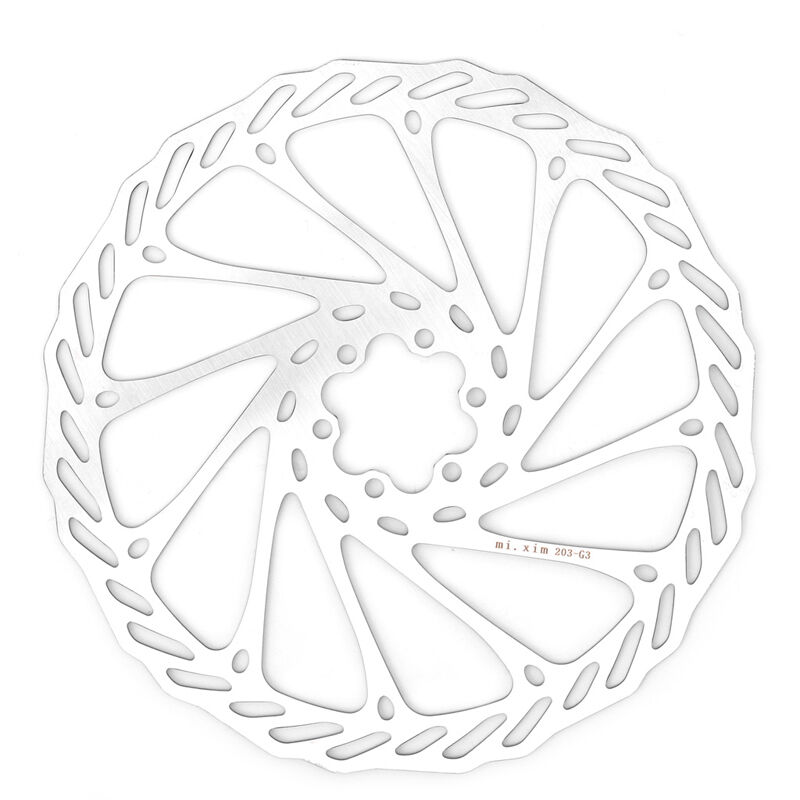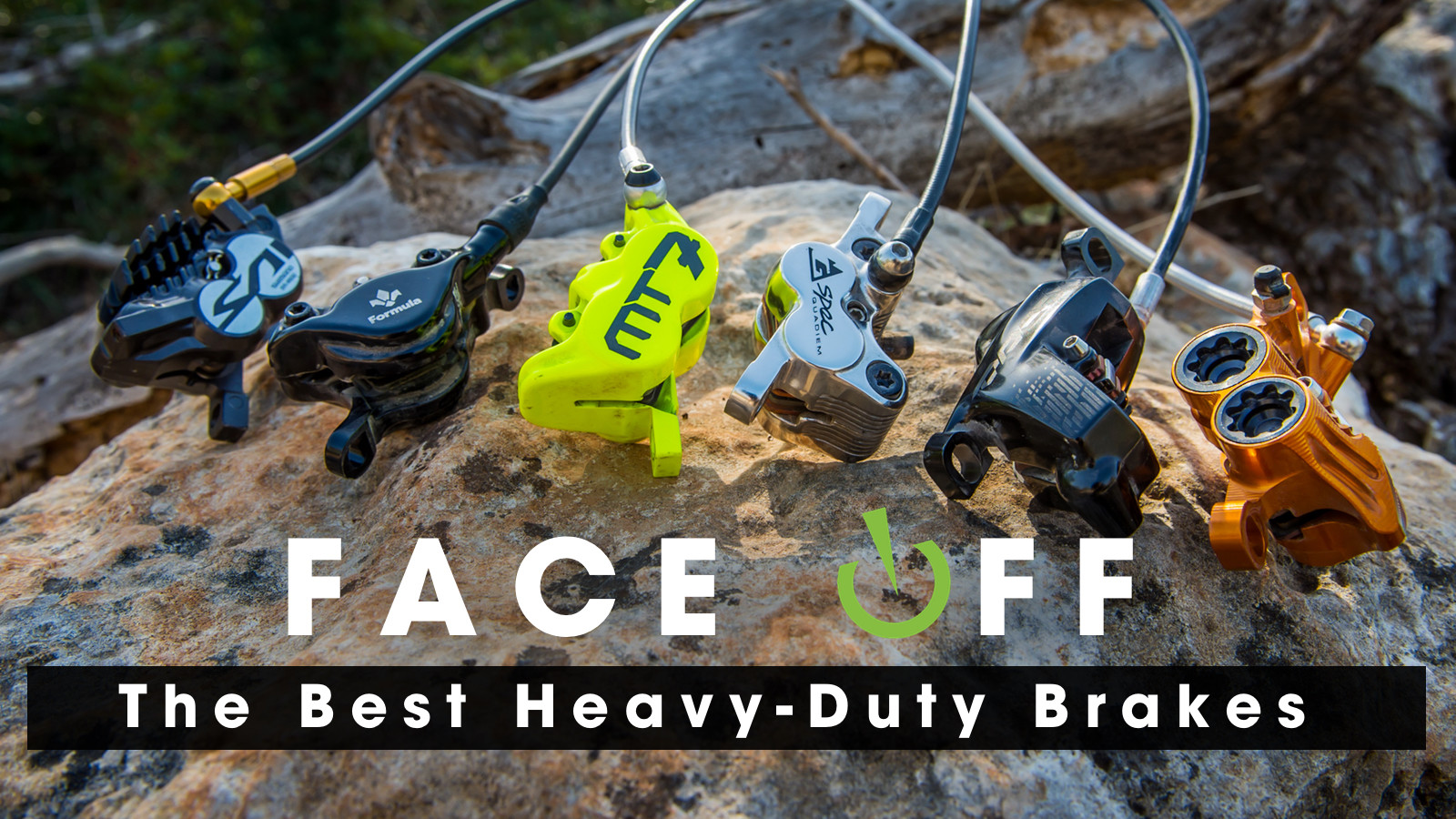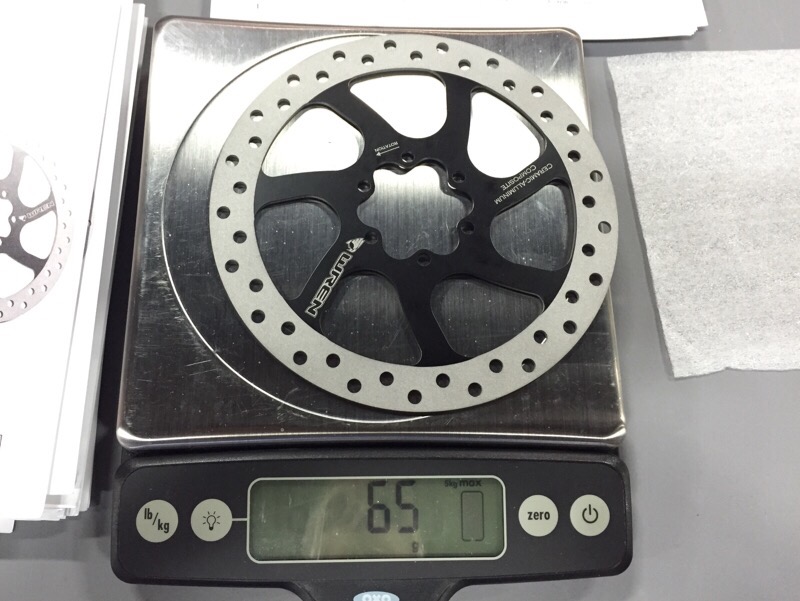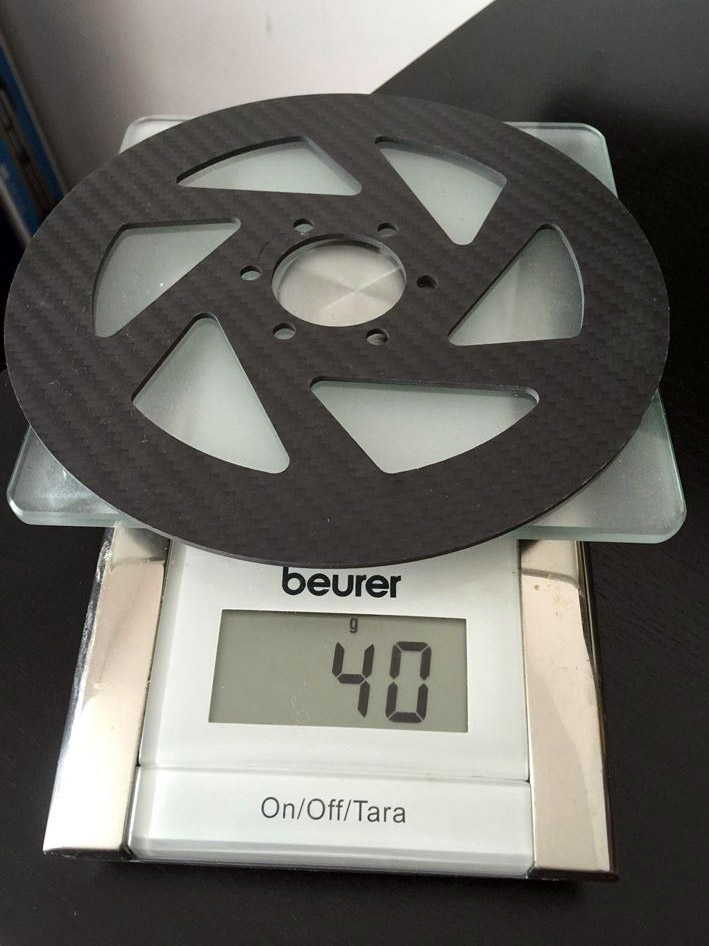Car brakes would be very large and heavy to use on a bicycle, even on some of the big heavy ebikes/trikes here on ES. Even larger and heavier than motorcycle brakes.eCue said:For drivers who demand the utmost from their car
You are using an out of date browser. It may not display this or other websites correctly.
You should upgrade or use an alternative browser.
You should upgrade or use an alternative browser.
Specific heat absorption capacity of disc brakes
- Thread starter DasDouble
- Start date
wturber
1 MW
DasDouble said:Alright, I see the point but then why do brands like brembo lead the market with their disc brakes? I mean there must be a reason for it, right?
Never underestimate the psychological/marketing aspects of a product or feature. For many people, disc brakes look cool and they associate them with superior braking on cars. They transfer that thinking to their bike purchase. So the disc brakes have a marketing edge with those people - regardless of the actual benefit. Look at all the fancy packaging involved with the products you buy. Doesn't help most products performance one bit. Yet billions are spent on it due to the marketing psychological impacts that good packaging has on getting people to buy stuff.
But to be clear, there are certainly good reasons for people to engineer and use good disc brakes on bicycles. Just be clear that they aren't always spec'd or purchased for those good reasons.
Note: Just noticed that Brembo makes car and motorcycle brakes. Disc brakes are generally the best choice in those applications. The energy that needs to be dissipated is far, far greater than what is typically encountered for bicycles and e-bikes. Disc brakes generally are a great choice for cars and motorcycles. This article discusses how disc brakes on large trucks. The choice of drum or disc isn't exactly automatic since the factors affecting the decision aren't quite the same.
http://www.truckinginfo.com/channel/safety-compliance/article/story/2014/07/brake-trends-drums-vs-discs.aspx
eCue
10 kW
Brembo's oversized calipers / rotors pretty much made their success. Bigger is better well within reason 
The cheap 203 Rotor I ordered from ebay.
The price was right $7 and $1 shipping
I figure stainless steel is stainless steel. I will find out how accurate that premise is after some miles. Should be fine...

Now its the waiting game for shipping
The cheap 203 Rotor I ordered from ebay.
The price was right $7 and $1 shipping
I figure stainless steel is stainless steel. I will find out how accurate that premise is after some miles. Should be fine...

Now its the waiting game for shipping
speedmd
10 MW
Nice looking rotor. Bigger is better and Certain to help.
Big family of materials in the Stainless grouping. Many are not good at all for the app. May explain some of the crumpling fails. The H or HR (heat resistant) grades would be better but still too broad a product range to address all the performance details that would make a ideal material for the job. I would think a non or low chromium high tungsten grade HSS (High speed steel) best for a light rotor app.
Big family of materials in the Stainless grouping. Many are not good at all for the app. May explain some of the crumpling fails. The H or HR (heat resistant) grades would be better but still too broad a product range to address all the performance details that would make a ideal material for the job. I would think a non or low chromium high tungsten grade HSS (High speed steel) best for a light rotor app.
eCue
10 kW
I will post back on its performance there is a chance it will be a squealer or like you mentioned be made of a low grade warp happy material ( hope not ) If the Rotor squeals I will try tuning the edges.
The TRP rotor on the bike now is silent ( with organic pads )
I should of really went with the 203 trp if not for low the price on the Chinese rotor I would of.
The TRP rotor on the bike now is silent ( with organic pads )
I should of really went with the 203 trp if not for low the price on the Chinese rotor I would of.
DRMousseau
100 W
liveforphysics said:Most bicycle brake rotors I've seen looked like they had artists make the designs to look flashy rather than doing a mechanical stress optimization.
Soooo true! And an Arts Degree shouldn't qualify you for engineering! I'll not get into my personal matters with degreed designers, engineers, and such, who may have never even held a screwdriver or perhaps never ridden a bicycle, etc., etc..... UGH!
But like autos, trucks, and motorcycles,... bicycles ARE much the same in that they must meet a certain set of specific governing rules and regs. These "specs" may not fully account for a runaway tractor/trailer on a prolonged steep downhill grade, or an overweight, modified bicycle carrying a 250lb rider and groceries at 30mph! Broadly speaking, the Consumer whatever-it-is, specs a bicycle (surprisingly defined with a 750w motor and 150# rider) to stop within 15feet from 20mph,... I believe it's repeated like 5 times or something. And outside of "sidewalk bicycles" (a defined class in itself), there is practically little more in guidance. So most any of the broadly varied extreme uses that many here subject their bicycles (and brakes) to, isn't much accounted for by "artists". And thankfully, there ARE manufactures who run a good R&D team for their product lines. Still, most are limiting given the need of the market. And, "extreme" e-bikes are kinda new yet,... will be nice to see development here, jus as I have watched bicycles over the last 50-60yrs. (That's when kids trikes, 24" "balloonies", and fancy "imports" were predominant. :lol: Wasn't easy makin the jump from a trike to curb assisted starts for an 8yr old!)
Seems everyone in this particular discussion, has a VERY unique need in application, AND various practical and real experiences to relate (myself included). And THAT'S why I luv this site so much! Much to consider in my new build,.... paved street use only, among traffic, TWO-adult carrying capacity, 100lb-PLUS bike weight, 2000w, 28mph speed (capability of near 40mph),... AND RELIABLE SAFE STOPPING, while maintaining a "bicycle" configuration!
eCue
10 kW
I have read some downhill specific racing mtb's front fork post mounts START at 203mm and apparently adapt up to 240mm.
I tried looking a few times for such rotors all I could find was a mention of them here and there, it appears they are specifically for team racers (a guess) Sram for instance makes a 220mm rotor but does not advertise it anywhere.
what i did find is this a page with some apparently heavy duty calipers on it
https://www.vitalmtb.com/features/Vital-MTB-Face-Off-The-Best-DH-Brakes,2152
How We Tested
We have prior long-term experience with all but the Cura. To put them all to the test under more or less equitable circumstances, we rode a set of each brake again for at least one month on the same bike under the same tester. We used 200mm or 203mm rotors up front and 180mm rotors out back each time.

I tried looking a few times for such rotors all I could find was a mention of them here and there, it appears they are specifically for team racers (a guess) Sram for instance makes a 220mm rotor but does not advertise it anywhere.
what i did find is this a page with some apparently heavy duty calipers on it
https://www.vitalmtb.com/features/Vital-MTB-Face-Off-The-Best-DH-Brakes,2152
How We Tested
We have prior long-term experience with all but the Cura. To put them all to the test under more or less equitable circumstances, we rode a set of each brake again for at least one month on the same bike under the same tester. We used 200mm or 203mm rotors up front and 180mm rotors out back each time.

Chalo
100 TW
speedmd said:I would think a non or low chromium high tungsten grade HSS (High speed steel) best for a light rotor app.
It needs to be bendable so you can align it (because nothing is perfect). And it should fail in a way that doesn't produce razor sharp fragments. HSS gets poor marks in both regards.
wturber
1 MW
Chalo said:speedmd said:I would think a non or low chromium high tungsten grade HSS (High speed steel) best for a light rotor app.
It needs to be bendable so you can align it (because nothing is perfect). And it should fail in a way that doesn't produce razor sharp fragments. HSS gets poor marks in both regards.
Recommendations from this thread were:
410, 420, 416 Stainless Steels and SAF 2205
http://forums.mtbr.com/brake-time/material-brake-rotors-523051.html
Raisedeyebrows
1 kW
As far as grabbing power with the same caliper, same amount of pull on the lever, does a 203mm rotor have substantially more than a 160mm rotor? Or is the difference just in heat dissipation?
wturber
1 MW
Raisedeyebrows said:As far as grabbing power with the same caliper, same amount of pull on the lever, does a 203mm rotor have substantially more than a 160mm rotor? Or is the difference just in heat dissipation?
It should have more mechanical advantage due to the larger radius. But I don't think "grabbing" power is really much of an issue with any disc or rim based system. They can all grab an stop a wheel pretty much immediately.
speedmd
10 MW
Chalo said:speedmd said:I would think a non or low chromium high tungsten grade HSS (High speed steel) best for a light rotor app.
It needs to be bendable so you can align it (because nothing is perfect). And it should fail in a way that doesn't produce razor sharp fragments. HSS gets poor marks in both regards.
What hardness are you assuming my friend. Normalized or half hard HSS would be no more brittle than those crappy grades of stainless and very easy to cold form. Most time folks are playing with this material it is glass hard and not what you would heat treat it for a rotor app. Stainless in general is a slippery material ( I deal with several grades daily ) and may be just a poor choice for ultimate performance and mainly used for cosmetic considerations.
speedmd
10 MW
Raisedeyebrows said:As far as grabbing power with the same caliper, same amount of pull on the lever, does a 203mm rotor have substantially more than a 160mm rotor? Or is the difference just in heat dissipation?
You would see a sizable increase in stopping power. 101/80mm radius would be roughly 1.26 times the leverage. It would also have a similar increase in heat dissipation area.
DRMousseau
100 W
Chalo said:speedmd said:I would think a non or low chromium high tungsten grade HSS (High speed steel) best for a light rotor app.
It needs to be bendable so you can align it (because nothing is perfect). And it should fail in a way that doesn't produce razor sharp fragments. HSS gets poor marks in both regards.
It needs to be A LOT of things, applicable to the needed application within certain parameters,... cost, technology, coordinated design with other components, intended use application, and much more.
wturber said:Recommendations from this thread were:
410, 420, 416 Stainless Steels and SAF 2205
http://forums.mtbr.com/brake-time/material-brake-rotors-523051.html
And with good reason!!!! Various stainless steels are probably the best choice for currently designed bicycle disk systems given "practical" considerations. Jus like those of automotive use, there is likely better choices in materials, but jus how "practical" those choices are, may often be limiting in some manner. Check the link below to explore some of those options, if you'd like. I'm kinda excited to see bicycle and e-bike specific options from mild to wild, that are likely being currently explored and developed with new and recent technologies.
https://www.scribd.com/doc/143773811/Material-Selection-for-Brake-Disc
Raisedeyebrows
1 kW
speedmd said:Raisedeyebrows said:As far as grabbing power with the same caliper, same amount of pull on the lever, does a 203mm rotor have substantially more than a 160mm rotor? Or is the difference just in heat dissipation?
You would see a sizable increase in stopping power. 101/80mm radius would be roughly 1.26 times the leverage. It would also have a similar increase in heat dissipation area.
Does the pad grab more disk on the bigger rotors giving it more powerful grab?, how does that work?
Raisedeyebrows
1 kW
wturber said:Raisedeyebrows said:As far as grabbing power with the same caliper, same amount of pull on the lever, does a 203mm rotor have substantially more than a 160mm rotor? Or is the difference just in heat dissipation?
It should have more mechanical advantage due to the larger radius. But I don't think "grabbing" power is really much of an issue with any disc or rim based system. They can all grab an stop a wheel pretty much immediately.
Back in my days of driving hundred dollar cars my motto was "I'll drive anything that stops". As far as bike brakes go I can appreciate a powerful smooth braking system with pleasing tone, nice bouquet on the modulation, absence of premature lock-up, good finish and of course pleasant aftertaste. Filled with organic mineral oil of course.
As noted in the part you quoted, it's the extra leverage from the larger radius.Raisedeyebrows said:Does the pad grab more disk on the bigger rotors giving it more powerful grab?, how does that work?
Get a phillps screwdriver out, chuck the bit end in a power drill, and try to stop it by hand holding only teh shaft, then try it with the larger radius handle instead.
Raisedeyebrows
1 kW
amberwolf said:As noted in the part you quoted, it's the extra leverage from the larger radius.Raisedeyebrows said:Does the pad grab more disk on the bigger rotors giving it more powerful grab?, how does that work?
Get a phillps screwdriver out, chuck the bit end in a power drill, and try to stop it by hand holding only teh shaft, then try it with the larger radius handle instead.
So what Chalo was pointing out about the huge radius of rim brakes making for a ton of leverage also applies to disks as well, the larger the radius the more grab? Thanks guys, I feel like I learned something today-always thought in terms of pads grabbing whatever they were trying to stop and how effective they were at that being the biggest determining factor.
liveforphysics
100 TW
Radius comes at the penalty of surface speed.
It's complex, and rotors have advantages in being small with high pad pressure as well as large with low pad pressure.
It's complex, and rotors have advantages in being small with high pad pressure as well as large with low pad pressure.
DRMousseau
100 W
liveforphysics said:It's complex,...
It's complex??? :lol:
I think that's over simplifying it. It's far beyond "complex"!!:wink:
Chalo
100 TW
speedmd said:Stainless in general is a slippery material ( I deal with several grades daily ) and may be just a poor choice for ultimate performance and mainly used for cosmetic considerations.
It's true that my best motorcycle disc brakes were some kind of carbon steel, made by EBC. They were better than stock in pretty much every regard I can think of.
Stainless alloys seem to tolerate surface wear relatively well; not as well as bearing bronze but better than plain steel. I'd be willing to try Ampco bronze or similar for disc rotors (expensive, but wear resistant and thermally more interesting than stainless). I've wanted to try that for a coaster brake hub shell for a long time.
I've never come across M2 high speed steel in any other state than glass hard, even after getting red hot in an ugly machining scenario. But I suppose that it's steel after all and thus can be annealed to some degree or another.
speedmd
10 MW
Looked into a few of the proven stainless alloys and I think now it is more than just overall cosmetic issues. It is a huge family of materials these days. Lots of considerations in surface scale and deterioration over time- use. The proven grades do also share many of the alloying elements that make HSS and many of the other hot work super alloys. I did notice that all of the great brands in brakes don't disclose alloy grades they use.
It is complex for certain. M2 and its family of high speed steels I use and know a bit about. It would wear well, hold its shape and strength at higher temps and would not be too slippery. Hardness and repeated heating- cooling most likely not be a issue but it is not cheap and would not be good with road salt. It can easily be made softer than drill bit hardness.
With stainless, the magnetic grades would be best most likely. The kitchen ware grades vary greatly depending on the app. Either should be hard enough and have chrome content in some balance or it would be too slick or gaul up badly in a friction app. One of the major issues we see in stainless, ever the higher hardness states is its ability to polish out with out pickup and stripping deep groves in the surface your trying to polish. Even high grades like 440 are still a bitch to get to a optical mirror. Just a indication of what will happen when used in this app. If too soft it will complain audibly and quickly deteriorate. If too hard, it will be slick. Lower chrome would be where I would err toward.
If that new rotor is screw driver hard it should be in a good hardness range. If it is hard against a file, it most likely is giving up significant amounts of stopping power. What it does after repeated hard stops and heat cycles needs to be reviewed on a alloy by alloy basis.
One of the alloys I played with a few years back that may be worth a look on these super thin fast ebike rotor setups is 52100. It can hold shape, harden to medium hardness without brittleness creeping in. Strong and low chrome also. Interesting stuff.
It is complex for certain. M2 and its family of high speed steels I use and know a bit about. It would wear well, hold its shape and strength at higher temps and would not be too slippery. Hardness and repeated heating- cooling most likely not be a issue but it is not cheap and would not be good with road salt. It can easily be made softer than drill bit hardness.
With stainless, the magnetic grades would be best most likely. The kitchen ware grades vary greatly depending on the app. Either should be hard enough and have chrome content in some balance or it would be too slick or gaul up badly in a friction app. One of the major issues we see in stainless, ever the higher hardness states is its ability to polish out with out pickup and stripping deep groves in the surface your trying to polish. Even high grades like 440 are still a bitch to get to a optical mirror. Just a indication of what will happen when used in this app. If too soft it will complain audibly and quickly deteriorate. If too hard, it will be slick. Lower chrome would be where I would err toward.
If that new rotor is screw driver hard it should be in a good hardness range. If it is hard against a file, it most likely is giving up significant amounts of stopping power. What it does after repeated hard stops and heat cycles needs to be reviewed on a alloy by alloy basis.
One of the alloys I played with a few years back that may be worth a look on these super thin fast ebike rotor setups is 52100. It can hold shape, harden to medium hardness without brittleness creeping in. Strong and low chrome also. Interesting stuff.
eCue
10 kW
I look at a larger rotors benefit like using a longer wrench to free a tight bolt with the added benefit of more surface area for faster cooling.
Its nice when the improvements stack up like that
I have read some Pro riders use oversized heat treated aluminum Rotors , can't find any online but did find these.
Ceramic/ aluminum rotor

Both would wear out much faster then stainless I imagine.
Ceramic carbon
A few years ago Spanish motorcycle company Alpha got a bit of a resurrection and at the same time made the transition also into e-bikes https://www.bikerumor.com/2016/11/1...-superlight-spanish-carbon-disc-brake-rotors/

from link
The result is claims of better heat management, improved braking in both wet and dry conditions, long wearing, and of course super light weight. This isn’t the first time we’ve seen carbon/ceramic rotors, but while we hadn’t tried those from Scappa, our first impression from the Kettle ones wasn’t so confidence inspiring. Alpha claims new tech that offers improved performance..
Its nice when the improvements stack up like that
I have read some Pro riders use oversized heat treated aluminum Rotors , can't find any online but did find these.
Ceramic/ aluminum rotor

Both would wear out much faster then stainless I imagine.
Ceramic carbon
A few years ago Spanish motorcycle company Alpha got a bit of a resurrection and at the same time made the transition also into e-bikes https://www.bikerumor.com/2016/11/1...-superlight-spanish-carbon-disc-brake-rotors/

from link
The result is claims of better heat management, improved braking in both wet and dry conditions, long wearing, and of course super light weight. This isn’t the first time we’ve seen carbon/ceramic rotors, but while we hadn’t tried those from Scappa, our first impression from the Kettle ones wasn’t so confidence inspiring. Alpha claims new tech that offers improved performance..
eCue
10 kW
speedmd said:One of the alloys I played with a few years back that may be worth a look on these super thin fast ebike rotor setups is 52100. It can hold shape, harden to medium hardness without brittleness creeping in. Strong and low chrome also. Interesting stuff.
You sound like a person who could make a good 220mm rotor for us ebikers
If your shop has a cnc machine you could start a Company up tomorrow
Raisedeyebrows
1 kW
Chalo said:speedmd said:Stainless in general is a slippery material ( I deal with several grades daily ) and may be just a poor choice for ultimate performance and mainly used for cosmetic considerations.
It's true that my best motorcycle disc brakes were some kind of carbon steel, made by EBC. They were better than stock in pretty much every regard I can think of.
Stainless alloys seem to tolerate surface wear relatively well; not as well as bearing bronze but better than plain steel. I'd be willing to try Ampco bronze or similar for disc rotors (expensive, but wear resistant and thermally more interesting than stainless). I've wanted to try that for a coaster brake hub shell for a long time.
I've never come across M2 high speed steel in any other state than glass hard, even after getting red hot in an ugly machining scenario. But I suppose that it's steel after all and thus can be annealed to some degree or another.
I really liked the rim brake you machined back in the day, the one you posted a photo of sometime ago, was that just a one-off you made for yourself?

